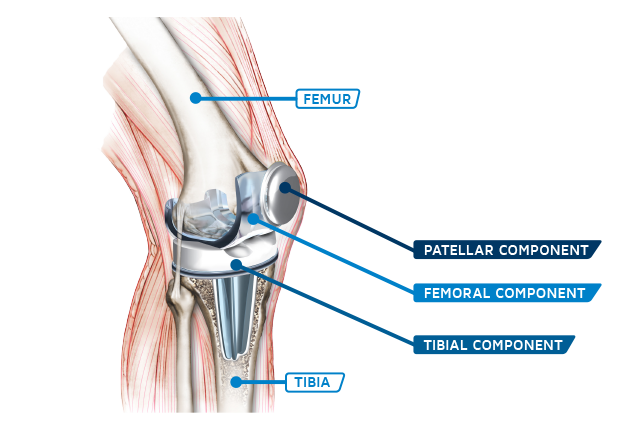Total Knee Replacement Services
Indications
The primary indication for a total knee arthroplasty is to relieve pain caused by severe arthritis when a nonoperative treatment fails. The destruction of articular cartilage can limit your ability to walk, climb stairs, and perform other functional activities.
Total Knee Arthroplasty Surgery

A knee replacement consists of three parts:
1. A femoral (thigh bone) component, which is made out of metal.
2. A tibial (lower leg bone) component, which is a metal component with a polyurethane spacer.
3. A patellar (knee cap) component, which is plastic and attached to the undersurface of the original knee cap.
During the surgery, the surgeon will remove the damaged cartilage and bone from the end of your femur and the top of your tibia. Then the surgeon will use trial parts to make sure they are the right size for your knee. Finally, the surgeon will clean the bone with saline solution and “glue” the prosthetic compartments with cement. You may have a pressed metal component where the metal is porous which allows your bone to grow into the metal. Every procedure is different, but they generally take up to 2 hours. Lastly, the surgeon will close the incision with sutures and staples. The incision for a total knee replacement is usually 8 to 10 inches long on the front of the knee.
Recovery
The recovery process after a total knee replacement varies depending on your previous level of activity, how your body responds to surgery, and your level of activity after surgery. The majority of people walk with a walker for 2-3 weeks and then move on to a cane until they feel stable enough to walk independently. You will notice swelling of the knee for up to 3-4 months after the surgery.
Often, after total knee replacement, you are referred to physical therapy that is done either in your home if you have difficulty leaving your home or in an outpatient clinic. The therapist will perform an evaluation on your level of function, strength, and range of motion. Based on the evaluation, the therapist will develop exercises and other treatments to help you reach your goals of increased function and decreased pain. Physical therapy rehabilitation after a total knee replacement usually lasts for 6-12 weeks. Your physical therapist will also help you determine when it is safe for you to start walking without using an assistive device.
Common and normal recovery signs include bruising around the knee and even down the leg. Bruising can look deep and dark. It might also look yellow or green in color. This bruising can develop as late as 3-5 days after surgery. This will resolve with time.






